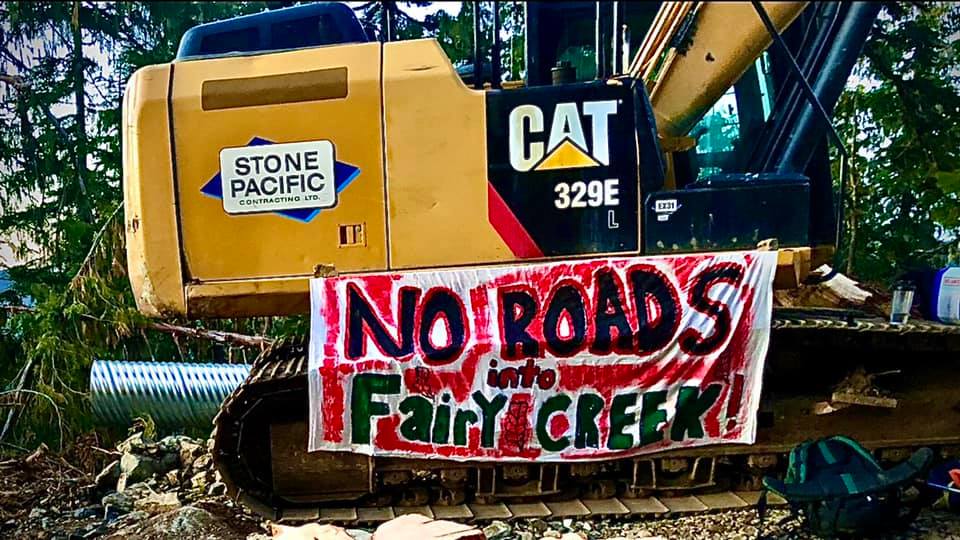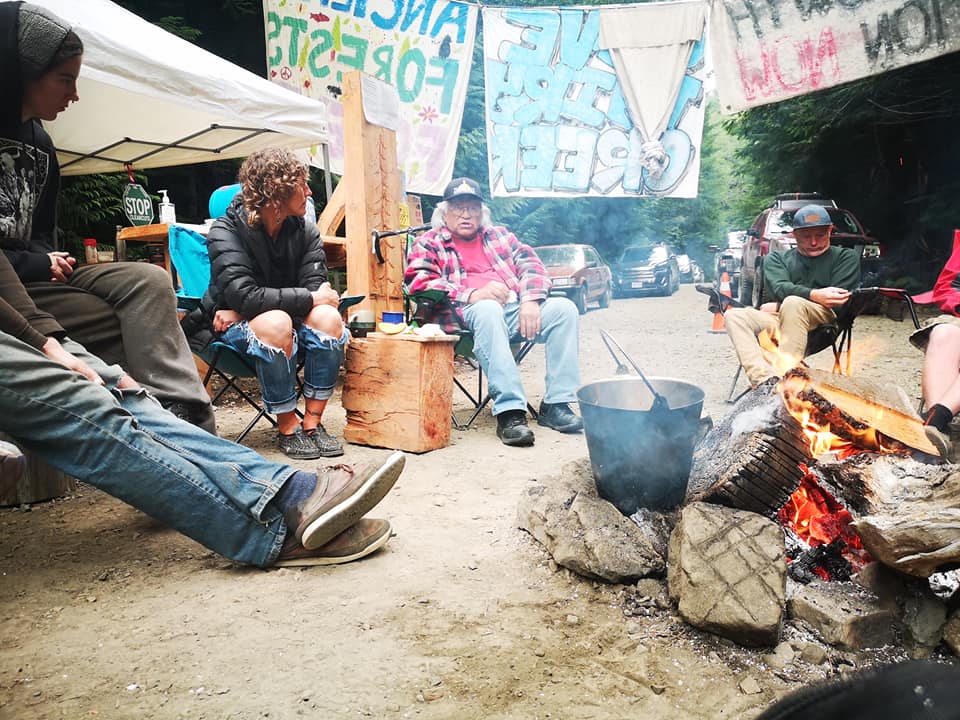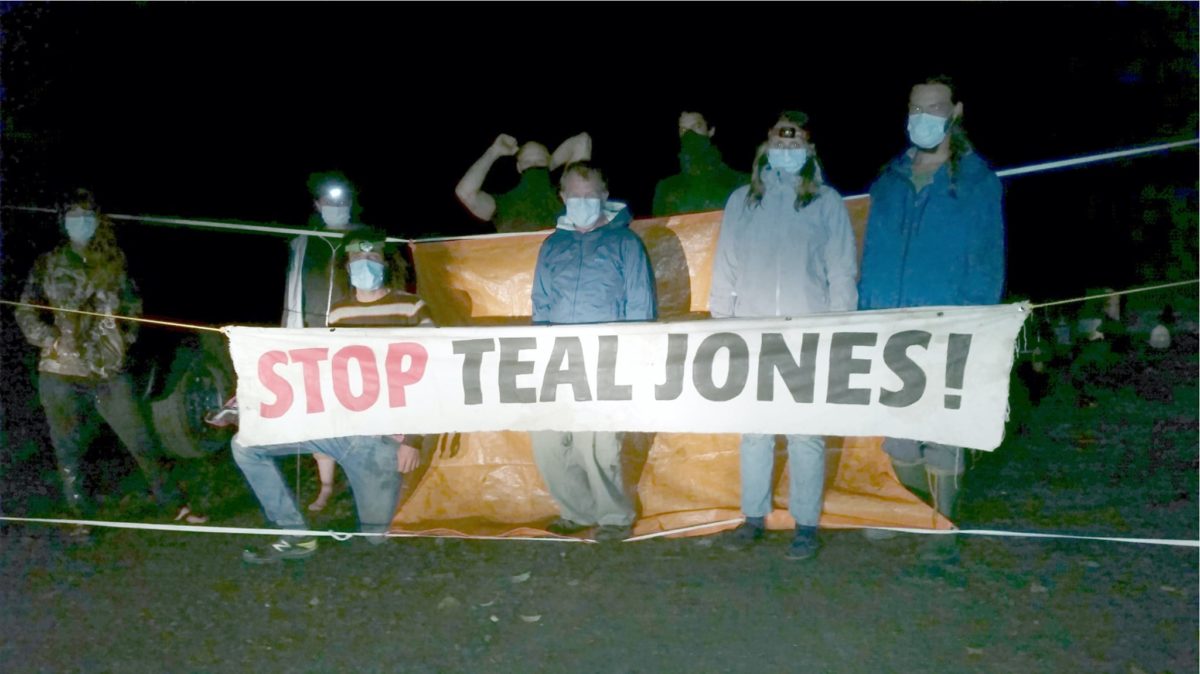Province has agreed to protect over 350 000 acres of old-growth forest but protesters want to see moratorium on logging of B.C.’s ancient trees

About 30 minutes northeast of Port Renfrew, near Fairy Lake on Pacheedaht territory, sit several camps blocking unfinished logging roads. Protesters huddle around tents and cooking utensils holding signs emblazoned with slogans such as “OLD GROWTH ACTION NOW” and “NO ROADS INTO FAIRY CREEK.”
This is the Fairy Creek blockade: a non-violent civil disobedience action seeking a moratorium on the logging of old-growth forests in B.C., a transition to the logging of second-growth trees instead, and collaboration between logging companies and Indigenous nations on resource projects.
The Fairy Creek Blockade
In early August, a small group of activists with a keen interest in the preservation of the province’s remaining old growth forests learned that a subcontractor of Teal-Jones Group, a Surrey-based logging company, was preparing to build a logging road into the Fairy Creek watershed with the intention of felling the region’s old-growth forest.
Only days later, on Aug. 10, a blockade was set up to stop the company from completing their logging road, which prevents access to the old-growth yellow cedars that are prevalent in the region. The blockade has now been in place for over a month from one camp to three as the movement has gained steam and as logging companies have tried to find new access points.

Members of the blockade, who refer to themselves as “forest defenders,” say that the Fairy Creek watershed is the last untouched old-growth watershed on southern Vancouver Island.
“It is a real priority, for me, to stop the destruction of these magnificent, internationally significant forests that [have] become so rare in the world today and play such an important role in mitigating against runaway climate change, in safeguarding biological diversity, and in offering healing to Indigenous communities,” said Bobby Arbess, one of the blockade’s organizers and a lifelong activist, in an interview with the Martlet.
Teal-Jones is the largest privately-owned logging company in B.C. They currently hold Tree Farm Licence 46, which includes large swaths of forest from central to southern Vancouver Island. The territory that is being logged and that the camp is located on belongs to the Pacheedaht nation. Teal-Jones has not released an official statement on the Fairy Creek blockade and did not respond to a request for comment by the Martlet.
The Protesters
Indigenous youth from a variety of nations and settlers have supported the blockades. There is no one background that those who have maintained the blockade come from.
Although the Pacheedaht Chief and Council have not taken an official stance either way on the blockades, in their 2019 land-use plan they claim that the construction of logging roads in the area has “created significant changes to the hydrology of many parts of the territory.”
Pacheedaht Elder Bill Jones, who has been a long-standing advocate for the protection of old-growth forests, has lent his support to the blockade.
“Bill is a lone voice within that community for protecting the forest and he has extended a warm and public invitation to people Indigenous and non-Indigenous to join him on the land to defend the last of these precious rain forests,” said Arbess.

Zoë Cilliers, a student in the Restoration of Natural Systems Diploma program at the University of Victoria, has spent multiple weeks at the camp and “more than that here in Victoria as a support.” Cilliers originally went to the Fairy Creek blockade to observe.
“At first, I went up just to learn and listen — not necessarily in support,” she said. “I wanted some assurance that proper protocol had been followed with the Pacheedaht, whose traditional territory the blockades are on — that the nation was aware and not in opposition to blockades and the goals made by the people there.”
In his efforts to follow protocol, Arbess sought assent from Jones, as there are no Pacheedaht hereditary chiefs. As well, members of the blockade have set up an Elder’s tent for Jones and have created a code of conduct. Jones has recommended that the Fairy Creek blockade hold decolonization workshops and provide food, supplies, and shelter to Indigenous visitors.
The history, relationships, and circumstances surrounding the blockade are very complex, and because of this, “the blockade has had its messy moments,” according to Cilliers. Even with these moments, she says she has learned a lot from the experience.
“I have had a month of incredible learning — about the history of protest movements here on Vancouver Island, about the intersection (and at times friction) between Western environmental movements and things like Indigenous sovereignty and decolonial theory,” she said.
Future old-growth preservation
One of the goals of the camp was to pressure the provincial government to release the report prepared by its Old Growth Strategic Review Panel, with the hope that Fairy Creek would be included in the areas of forest recommended for protection. They succeeded in one aim, and the document was released in early September after being written in late April 2020. It includes recommendations to protect over 353 000 acres of old growth forest in nine regions across the province, to come up with new sustainable logging practices, and to give Indigenous nations more say in resource development. The province has said that it will work to implement these recommendations.
While the report was celebrated by many groups, like the Ancient Forest Alliance, for recommending the protection of large areas in B.C. and Vancouver Island, it made no mention of old-growth forests on southern Vancouver Island such as Fairy Creek and Edinburgh Mountain.
Arbess, who is also a founding member of the environmental group Friends of Carmanah Walbran, which works to protect old growth forests in the Kaxi:ks (Walbran Valley) on Pacheedaht territory, says that southern Vancouver Island’s old-growth forests have been decimated and that while the government’s protection of 353 000 acres of old-growth forest represents a start, a moratorium on old-growth logging is needed.
“These forests that host some of the largest trees and the oldest trees found anywhere on earth have been reduced to slums of stumps and flies that are dramatically lacking in biological diversity,” Arbress stated. “I feel that it is a moral travesty of monumental proportions that the government continues to allow these rare old forests to be logged for short-term profit and just a very few jobs.”
Looking to the future, Cilliers sees a need for more fundamental change.
“Standing in front of a logging truck is a band aid — and it’s short-term,” she said. “Supporting the Pacheedaht Nation in the reclamation of their territory, sovereignty, and power of the land is the long-term solution.”
It remains yet to be seen how Teal-Jones will respond to the blockades in the long-term. Regardless of Teal-Jones’s course of action, land defenders at Fairy Creek say they are determined to protect the land no matter what.








